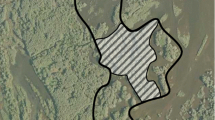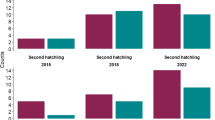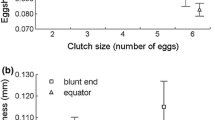Summary
In Fennoscandia the Goldcrest regularly lays two clutches per breeding season. Near Trondheim in Central Norway (about 63° N) the mean size of 11 first clutches was 10.4 (9–12) eggs and of 10 second/repeat clutches 9.4 (8–11) eggs. Mean egg length was 13.49 mm, breadth 10.35 mm, mean weight of freshly-laid eggs 0.78 g, volume 737 mm3 and shape index 130.6. The correlation coefficient for egg length against weight was 0.47, and for egg breadth against weight 0.77. For the four clutches studied in more detail, all egg dimensions, except the shape index, increased with the laying sequence. On average, the last-laid egg was 20.1 % heavier than the first-laid egg, or 5.6 % heavier than the mean weight for the whole clutch. The 3–5 last-laid eggs in the clutch deviated by about the same magnitude from the clutch mean. Because of the pronounced asynchrony in hatching, the size-hierarchy within a Goldcrest brood may be considerable, at least 1:5. The survival chances of the smallest young in a brood apparently depend mainly on the prevailing food supply. The primary advantage of hatching from a relatively large-sized egg is probably that such a hatchling is strong enough to secure itself a favourable feeding position in the crowded nest, in which the young often form 2–3 horizontal layers. The parental selection of food is adjusted to the size of the young, even in a brood with a marked size-hierarchy. It is concluded that the Goldcrest has evolved a brood reduction strategy.
Zusammenfassung
In Fennoskandien zeitigt das Wintergoldhähnchen regelmäßig zwei Gelege pro Brutsaison. In einem Kontrollgebiet bei Trondheim in Mittelnorwegen (ca. 63° N) betrug die mittlere Gelegegröße für 11 Erstgelege 10,4 (9–12) und für 10 Zweit- bzw. Ersatzgelege 9,4 (8–11) Eier. Die mittlere Eilänge betrug 13,5 mm, die Eibreite 10,35 mm, das mittlere Frischvollgewicht 0,78 g; das Volumen maß 737 mm3, der Eiformindex (=Länge/Breite × 100) 130,6. Die Korrelation zwischen Länge und Gewicht betrug 0,47, zwischen Breite und Gewicht 0,77. Bei vier genauer untersuchten Gelegen nahmen alle Eidimensionen mit Ausnahme des Eiformindex mit der Legefolge zu. Im Mittel war das letzte Ei 20,1 % schwerer als das erste oder 5,6 % schwerer als das mittlere Gewicht des gesamten Geleges; letzteres gilt auch für die 3 bis 5 zuletzt gelegten Eier. Als Folge des bemerkenswert asynchronen Schlupfes sind die Größenunterschiede innerhalb einer Goldhähnchenbrut beachtlich, nämlich mindestens 1:5. Die Überlebenschancen des kleinsten Jungen einer Brut hängen offensichtlich vor allem vom Nahrungsangebot ab. Der primäre Vorteil eines Jungen aus einem großen Ei liegt möglicherweise darin, daß dieser Nestling stark genug ist, um sich eine günstige Position im dichtbesetzten Nest bei den Fütterungen zu sichern. Die Jungen liegen oft in zwei bis drei Schichten übereinander. Die Nahrungswahl der Altvögel richtet sich nach der Jungengröße, sogar in einer Brut mit deutlichen Größenunterschieden. Das Wintergoldhähnchen hat wahrscheinlich die Strategie einer Brutreduzierung in Anpassung an knappes Nahrungsangebot entwickelt.
Similar content being viewed by others
Literature
Byrkjedal, I., &J. A. Kålås (1985): Seasonal variation in egg size in Golden PloverPluvialis apricaria and DotterelCharadrius morinellus populations. Orn. Scand. 16: 108–112.
Clark, A. B., &D. S. Wilson (1981): Avian breeding adaptations: hatching asynchrony, brood reduction, and nest failure. Quart. Rev. Biol. 56: 253–277.
Collett, R. (1921): Norges Fugle. Vol. I. Kristiania; Aschehoug & Co.
Curry-Lindahl K. (Ed.) (1963): Våra fåglar i Norden. Vol. IV. Sec. ed. Stockholm, Natur och Kultur.
Glutz v. Blotzheim, U. N. (1962): Die Brutvögel der Schweiz. Aarau; Tagblatt.
Haftorn, S. (1978 a): Cooperation between the male and female GoldcrestRegulus regulus when rearing overlapping double broods. Orn. Scand. 9: 124–129.
(1978 b): Egg-laying and regulation of egg temperature during incubation in the GoldcrestRegulus regulus. Orn. Scand. 9: 2–21.
(1978 c): Weight increase and feather development in the GoldcrestRegulus regulus. Orn. Scand. 9: 117–123.
(1982): Parental care of nestlings by the GoldcrestRegulus regulus. Orn. Fenn. 59: 123–134.
(1985): Variation in clutch size and egg dimensions of the Great TitParus major. Fauna norv. Ser. C, Cinclus 8: 106–115.
Hagen, Y. (1952): Rovfuglene og viltpleien. Oslo; Gyldendal norsk forlag.
Howe, H. F. (1976): Egg size, hatching asynchrony, sex, and brood reduction in the Common Grackle. Ecology 57: 1195–1207.
Hoyt, D. F. (1979): Practical methods of estimating volume and fresh weight of bird eggs. Auk 96: 73–77.
Hussel, D. J. T. (1985): On the adaptive basis for hatching asynchrony: brood reduction, nest failure and asynchronous hatching in Snow Buntings. Orn. Scand. 16: 205–212.
Jones, P. J. (1973): Some aspects of the feeding ecology of the Great TitParus major L. Unpubl. Ph. D. thesis, Oxford Univ.
Kluyver, H. N. (1952): Notes on body weight and time of breeding in the Great TitParus major L. Ardea 40: 123–141.
Lack, D. (1947): The significance of clutch size. Parts I and II. Ibis 89: 302–352.
(1954): The natural regulation of animal numbers. Oxford; Clarendon Press.
(1966): Population studies of birds. Oxford; Clarendon Press.
Moss, R., &A. Watson (1982): Heritability of egg size, hatch weight, body weight, and viability in Red Grouse (Lagopus lagopus scoticus). Auk 99: 683–686.
Nice, M. M. (1937): Studies in the life history of the Song Sparrow, part 1. Trans. Linnaean Soc., New York.
Niethammer, G. (1937): Handbuch der deutschen Vogelkunde. Vol. I. Leipzig.
O'Connor, R. J. (1978): Growth strategies in nestling passerines. Living Bird 16: 209–223.
Ojanen, M. (1983): Significance of variation in egg traits in birds, with special reference to passerines. Acta Univ. Oul. A 154, Biol. 20: 1–48.
Palmgren, P. (1932): Zur Biologie vonRegulus r. regulus (L.) undParus atricapillus borealis Selys. Acta Zool. Fenn. 14: 1–113.
Petersen, A. (1955): The breeding cycle in the Bank Swallow. Wilson Bull. 67: 235–286.
Ricklefs, R. E. (1965): Brood reduction in the Curve-billed Thrasher. Condor 67: 505–510.
&W. A. Montevecchi (1978): The relationship between egg size and chick size in the Laughing Gull and Japanese Quail. Auk 95: 135–144.
Schifferli, L. (1973): The effect of egg weight on subsequent growth of nesting Great TitsParus major. Ibis 115: 549–558.
Ditto (1976): Factors affecting weight and condition in the House Sparrow, particularly when breeding. Unpubl. Ph. D. thesis, Oxford Univ.
Slagsvold, T. (1985): Asynchronous hatching in passerine birds: influence of hatching failure and brood reduction. Orn. Scand. 16: 81–87.
&M. Husby (1984): On the adaptive value of intraclutch egg-size variation in birds. Auk 101: 685–697.
Svensson, B. W. (1978): Clutch dimensions and aspects of the breeding strategy of the ChaffinchFringilla coelebs in northern Europe: a study based on egg collections. Orn. Scand. 9: 66–83.
Thaler, E. (1979): Das Aktionssystem von Winter- und Sommergoldhähnchen (Regulus regulus, R. ignicapillus) und deren ethologische Differenzierung. Bonner Zool. Monogr. 12: 1–151.
Witherby, H. F. (Ed.) (1945): The handbook of British birds. Vol. I. London.
Author information
Authors and Affiliations
Rights and permissions
About this article
Cite this article
Haftorn, S. Clutch size, intraclutch egg size variation, and breeding strategy in the GoldcrestRegulus regulus . J Ornithol 127, 291–301 (1986). https://doi.org/10.1007/BF01640412
Published:
Issue Date:
DOI: https://doi.org/10.1007/BF01640412




